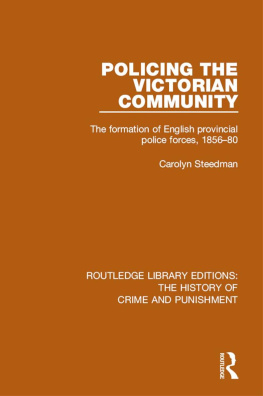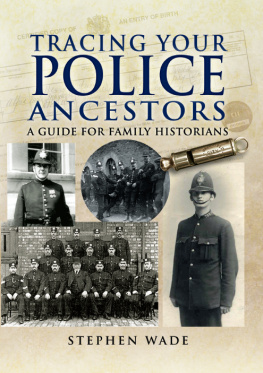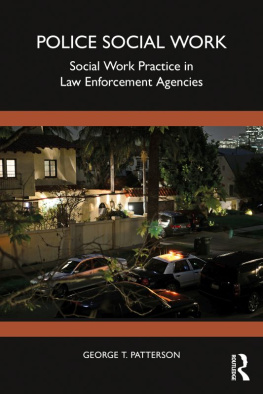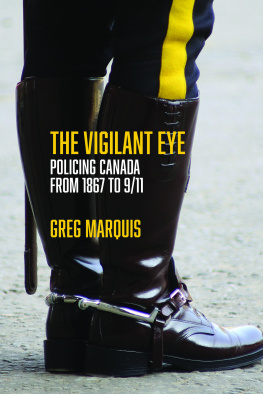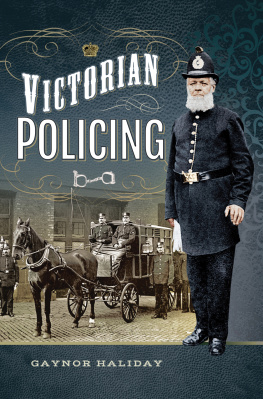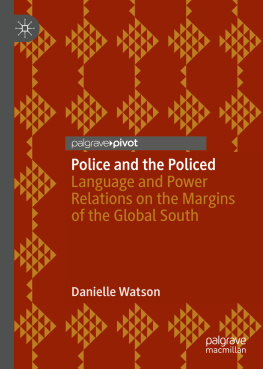ROUTLEDGE LIBRARY EDITIONS: THE HISTORY OF CRIME AND PUNISHMENT
Volume 9
POLICING THE VICTORIAN COMMUNITY
POLICING THE VICTORIAN COMMUNITY
The formation of English provincial police forces, 185680
CAROLYN STEEDMAN
First published in 1984 by Routledge & Kegan Paul Plc
This edition first published in 2016
by Routledge
2 Park Square, Milton Park, Abingdon, Oxon OX14 4RN
and by Routledge
711 Third Avenue, New York, NY 10017
Routledge is an imprint of the Taylor & Francis Group, an informa business
1984 Carolyn Steedman
All rights reserved. No part of this book may be reprinted or reproduced or utilised in any form or by any electronic, mechanical, or other means, now known or hereafter invented, including photocopying and recording, or in any information storage or retrieval system, without permission in writing from the publishers.
Trademark notice: Product or corporate names may be trademarks or registered trademarks, and are used only for identification and explanation without intent to infringe.
British Library Cataloguing in Publication Data
A catalogue record for this book is available from the British Library
ISBN: 978-1-138-94552-4 (Set)
ISBN: 978-1-315-67131-4 (Set) (ebk)
ISBN: 978-1-138-94372-8 (Volume 9) (hbk)
ISBN: 978-1-138-94373-5 (Volume 9) (pbk)
ISBN: 978-1-315-67224-3 (Volume 9) (ebk)
Publishers Note
The publisher has gone to great lengths to ensure the quality of this reprint but points out that some imperfections in the original copies may be apparent.
Disclaimer
The publisher has made every effort to trace copyright holders and would welcome correspondence from those they have been unable to trace.
POLICING THE VICTORIAN COMMUNITY
The formation of English provincial police forces, 1856-80
Carolyn Steedman
First published in 1984
by Routledge & Kegan Paul Plc
39 Store Street, London WC1E 7DD,
9 Park Street, Boston, Mass. 02108, USA,
296 Beaconsfield Parade, Middle Park,
Melbourne, 3206, Australia, and
Broadway House, Newtown Road
Henley-on-Thames, Oxon RG9 1EN
Printed in Great Britain by
Hartnoll Print, Bodmin, Cornwall
Carolyn Steedman 1984
No part of this book may be reproduced in any form without permission from the publisher, except for the quotation of brief passages in criticism.
Library of Congress Cataloging in Publication Data
Steedman, Carolyn.
Policing the Victorian community.
(Routledge direct editions)
Bibliography: p.
Includes index.
1. Police--England--History--19th century. 2. England--Politics and government. 3. County government--England--History--19th century. 4. Boroughs--England--History--19th century. 5. Labor and laboring classes--England--History--19th century.
I. Title.
HV8195.A5E5371983.363.2'094283-4467
ISBN 0-7100-9575-9
CONTENTS
The original research on which this book is based was prompted by a silence on the part of mid-nineteenth-century commentators on the questions of police and policing in provincial England. This nineteenth-century absence of comment was echoed in the few police histories that were available twelve years ago, which dealt in almost exclusively Metropolitan terms.
Yet it was clear that the analytic silence of the mid-Victorian years masked theories of control and management that were used in the governmental circles of provincial communities in the years after 1856, the date of the first compulsory police act. It has been pointed out that much modern sociological investigation of the police assumes that we know what the police, as an institution, really is. This casual assumption of knowledge allows common-sense definitions to take the place of theoretical understanding, ()
It became obvious very early during the course of the research on which this book is based that the ideology that informed the government and control of mid-nineteenth-century provincial communities could not often be revealed by the use of modern definitions of police and policing, whether they were of the common-sense or analytic variety. A complicated set of theories underlay the management of provincial police forces between 1856 and 1880. As the roots of those theories lay in various contemporary perceptions of a governmental and social context, then they had to be interpreted in the light of that context.
This book attempts to deal with the particularity of that perception; and so it becomes not so much an account that tells of the police (though it certainly does that) as of the way in which a society, at many levels, and from many class perspectives, understood itself to operate, and of the way in which theories of ownership, servitude, obligation, and the reciprocality of social relations manifested themselves in different communities.
In pursuit of a mid-nineteenth-century particularity, this books deals, among other questions, with the division of labour in police hierarchies, the emergence of Victorian policing as both a craft ) Had recent sociological investigations been available ten years ago then my archive research could have been directed somewhat differently and much more easily. Particularly, the question of who controls a working-class police in a class society could have been pursued more sharply and directly.
However, the final historical narrative would have remained much the same. This seems particularly clear over the question of policing. A complex and sophisticated definition of policing has emerged from recent sociological inquiry, an account of the way in which societies might be regulated through the manipulation of ideas and images as much as through coercion. () Had this kind of definition been available in 1970, I would have had a label for what I was searching, and a sharper understanding of what magistrates and watch committee members were up to as they manipulated the metaphors of soldiers and servants in sending their policemen upon the streets. In fact, the mid-nineteenth-century theory and practice of policing that emerges from these pages is the historical groundwork of more recent definitions.
Most of the archive research on which this book is based was undertaken when I was a post-graduate student at Cambridge between 1969 and 1972. An earlier account is deposited in Cambridge University Library. () In fact, 19 & 20 Vict. c.69 had a profound effect on the local administration of local law, and the policing that upheld it.
This book has been some time in the making, and those who have helped me with their comment and advice over the years may well have forgotten doing so. I should like to express my gratitude to the following people: Henry Parris, Peter Hennock, John Vincent, Geoffrey Best, Mr D. T. Brett, the Librarian of the Police College at Bramshill, Mr F. B. Stitt, the Archivist of the County of Staffordshire, Gill Sutherland, Raphael Samuel, Philip Donnellan, whose BBC television production Gone for a Soldier, broadcast in March 1980 led me to John Pearmans Memoirs; and Karen Clarke. More recently, the advice of Stephen Yeo, Rodney Mace and Maureen Cain has been invaluable. Peter and Betty Pearman of Silver Springs, Maryland generously provided me with hospitality, access to John Pearmans Memoirs, family letters and memories, during January 1981. I am extremely grateful for their help.

